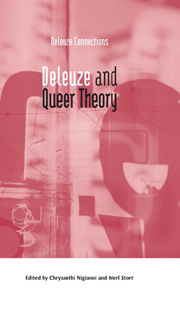Book contents
- Frontmatter
- Contents
- Introduction
- 1 On the Very Possibility of Queer Theory Claire Colebrook
- 2 Thirty-six Thousand Forms of Love: The Queering of Deleuze and Guattari
- 3 The Sexed Subject in-between Deleuze and Butler Anna Hickey-Moody and Mary Lou Rasmussen
- 4 Every ‘One’ – a Crowd, Making Room for the Excluded Middle
- 5 The Adventures of a Sex
- 6 Queer Hybridity
- 7 Prosthetic Performativity: Deleuzian Connections and Queer Corporealities
- 8 Unnatural Alliances
- 9 Schreber and the Penetrated Male
- 10 Butterfly Kiss: The Contagious Kiss of Becoming-Lesbian Chrysanthi Nigianni
- Notes on Contributors
- Index
5 - The Adventures of a Sex
Published online by Cambridge University Press: 12 September 2012
- Frontmatter
- Contents
- Introduction
- 1 On the Very Possibility of Queer Theory Claire Colebrook
- 2 Thirty-six Thousand Forms of Love: The Queering of Deleuze and Guattari
- 3 The Sexed Subject in-between Deleuze and Butler Anna Hickey-Moody and Mary Lou Rasmussen
- 4 Every ‘One’ – a Crowd, Making Room for the Excluded Middle
- 5 The Adventures of a Sex
- 6 Queer Hybridity
- 7 Prosthetic Performativity: Deleuzian Connections and Queer Corporealities
- 8 Unnatural Alliances
- 9 Schreber and the Penetrated Male
- 10 Butterfly Kiss: The Contagious Kiss of Becoming-Lesbian Chrysanthi Nigianni
- Notes on Contributors
- Index
Summary
In queer theory the question of what is sex has been rethought in terms of the biological plasticity of the body as evidenced, for example, by hormone and genetic ambivalences neutralising the distinction between masculinity and femininity, female and male, leading to a notion of fundamental queerness of all sexes. The importance of such a notion lays in its indirect suggestion that sex, as the natural source of (culturally constructed) gender, does not coincide with the immutable fixed order of nature. On the other hand, however, a more explicitly political tendency in queer theory has reshaped the indirect claim for a fundamental queer biologism and has rather argued for the centrality of the discursive apparatus of power forming the complexity of sexual identities through practices of performativity. Here, the bio-logic of queerness is explained in terms of a gendered materiality, constantly being reconfigured by discursive apparatuses. For queer theory, such discursive exercises of power – or bio-power having material effects on the body-sex – is constantly open to resistance by the subversive performativity of signs, leading to ruptures in meanings, positions, roles of the gender-sex identification.
The centrality of performativity in queer theory has been recently reelaborated in terms of posthuman material-discursive intra-actions, suggesting a new alliance between science and ontology (Barad 2005). However, this article suggests that the question of how does sexuality become queer remains still largely unaddressed in such posthuman queer theory, to the extent that sex, or what is given in sexuality, remains anchored to the primacy of gender as phenomena-in-things (Barad 2002), in the same way as materiality remains determined by the performativity of material-discursive apparatuses.
- Type
- Chapter
- Information
- Deleuze and Queer Theory , pp. 72 - 91Publisher: Edinburgh University PressPrint publication year: 2009



